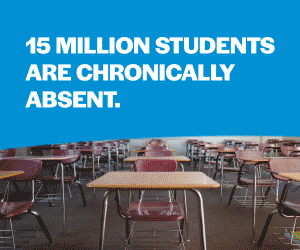 Sarasota County Schools (Fla.) Superintendent Terry Connor held more than two dozen community discussions in 2024 about an upcoming millage referendum, which later passed with 84 percent of the vote.
Sarasota County Schools (Fla.) Superintendent Terry Connor held more than two dozen community discussions in 2024 about an upcoming millage referendum, which later passed with 84 percent of the vote.
“Students spend around 80 percent of their time outside the classroom. To create transformational change, schools must influence the community by developing networks and providing wraparound services,” says Bob Runcie, chief executive officer of Chiefs for Change, a national network of state and district education leaders.
Runcie says navigating the political dimensions of the job is the top challenge for superintendents in his organization. Developing civic leadership skills, actively engaging the community, and building trust between schools, families, and the community are all crucial to gaining support.
Here are some community engagement strategies inspired by education leaders nationwide.
1. Ensure communication is clear and transparent
It is vital that all communication channels—websites, emails, social media, robocalls, and texting—are reliable and easy for the community to use, and that staff members are trained in best practices for delivering information so that parents can clearly understand all communication. This may require translation services for families and households where English is not the primary language.
Bill Runey, superintendent of Dighton-Rehoboth Regional School District in Massachusetts, keeps his district informed with a structured communication cadence. Tools like the Smore newsletter platform allow families to receive the district’s Friday Family newsletter, which is also translated into several languages.
Similarly, Eric Conti, superintendent of Burlington Public Schools in Massachusetts, emphasizes transparency. “Parents want to see the curriculum and know what their children will be doing ahead of time,” he says. At a recent literacy night, Burlington provided live translation services through Lexikeet, accommodating the five primary languages of the town’s 57 spoken languages.
2. Gather feedback through regular surveys
 Social studies students at Community High School District 99 in Illinois hear stories from area veterans to learn about their pasts.
Social studies students at Community High School District 99 in Illinois hear stories from area veterans to learn about their pasts.
3. Host community-centric events
 An open house at a middle school in Lamoille North Supervisory Union in Vermont. The district has taken steps to improve turnout, including offering free dinner and childcare at board meetings.
An open house at a middle school in Lamoille North Supervisory Union in Vermont. The district has taken steps to improve turnout, including offering free dinner and childcare at board meetings.
District leaders in Lamoille North are also considering providing courses on cooking, reading, and driver’s education to support newcomer families.
4. Build partnerships with business, nonprofits, and local government agencies
Lamoille North partners with health departments and restorative justice organizations to write grants and bring services like mental health clinicians into schools. “Our leadership team includes community business leaders who help with initiatives focused on reducing absenteeism, providing student mentoring, and improving student engagement,” says Superintendent Catherine Gallagher.
5. Hold summits to discuss initiatives and celebrate achievements
The San Mateo-Foster City School District in California, which has a high percentage of English learners, addresses literacy challenges with a multi-pronged strategy. In October 2024, the district hosted a Preschool Equity Summit that included 15 agencies, celebrating a 300-percent enrollment increase in its early education programs as part of efforts to expand access and better prepare students for kindergarten success.
In 2023, the district hosted its first Literacy Summit, a two-day event featuring educators, policymakers, parents, community members, and literacy experts, discussing strategies and cooperative practices that can improve reading outcomes for all students.
6. Create opportunities for genuine dialogue
On becoming Sarasota County Public Schools’ superintendent after the Florida district experienced decades of tumultuous leadership turnover, Terry Connor prioritized relationship-building during his first 100 days in the summer and fall of 2023, meeting with staff, area foundations, elected officials, and other local leaders.
As the 2024 election and a referendum approached, he held “Coffee with Connor” events to prioritize transparency and emphasize cooperation over political polarization. “We held 25 face-to-face and virtual meetings where we discussed spending, accountability, and how our new programs will be aligned with local economic demands,” Connor says. The dialogue paid off when voters overwhelmingly approved a millage referendum with 84 percent support—the highest level in the state.
7. Involve families in policy development and decision making
Becoming interim superintendent for Seattle Public Schools in 2011 after a period of financial scandals and distrust in the district, Susan Enfield hosted open office hours, offering anyone in the community 15 minutes of her time. “It’s important for people to feel welcome and see that real people work here,” Enfield explains.
Enfield says the next step is to find ways to turn trust into engagement. As superintendent at two other districts, Enfield started family action committees. “Action—not advisory—committees,” she clarifies. “We’d bring draft Board policies to them if it impacted the family, such as a cell phone use policy, for the committees to help us develop.”
8. Connect the community with needed resources
Since 2013, Fontana Unified School District has collaborated with a diverse range of community providers to connect families with resources they may need, from food pantries to rental assistance, mental health services and legal counseling.
The district employed community aides in all its 45 schools, helping connect community members with essential services like tutoring, school supplies, food assistance, and help with medical appointments.
“For middle and high schoolers, we provide additional support,” explains Michael Garcia, senior director of family and community engagement. “If a student is struggling with academics, attendance, or behavior, our school outreach liaisons might conduct a home visit with the community aide. Once we see what they need, whether it’s a pair of shoes or help with insurance issues, we work with local faith-based, healthcare and other organizations to help.”
Ellen Ullman is a freelance writer and contributor to DATIA K12.



























